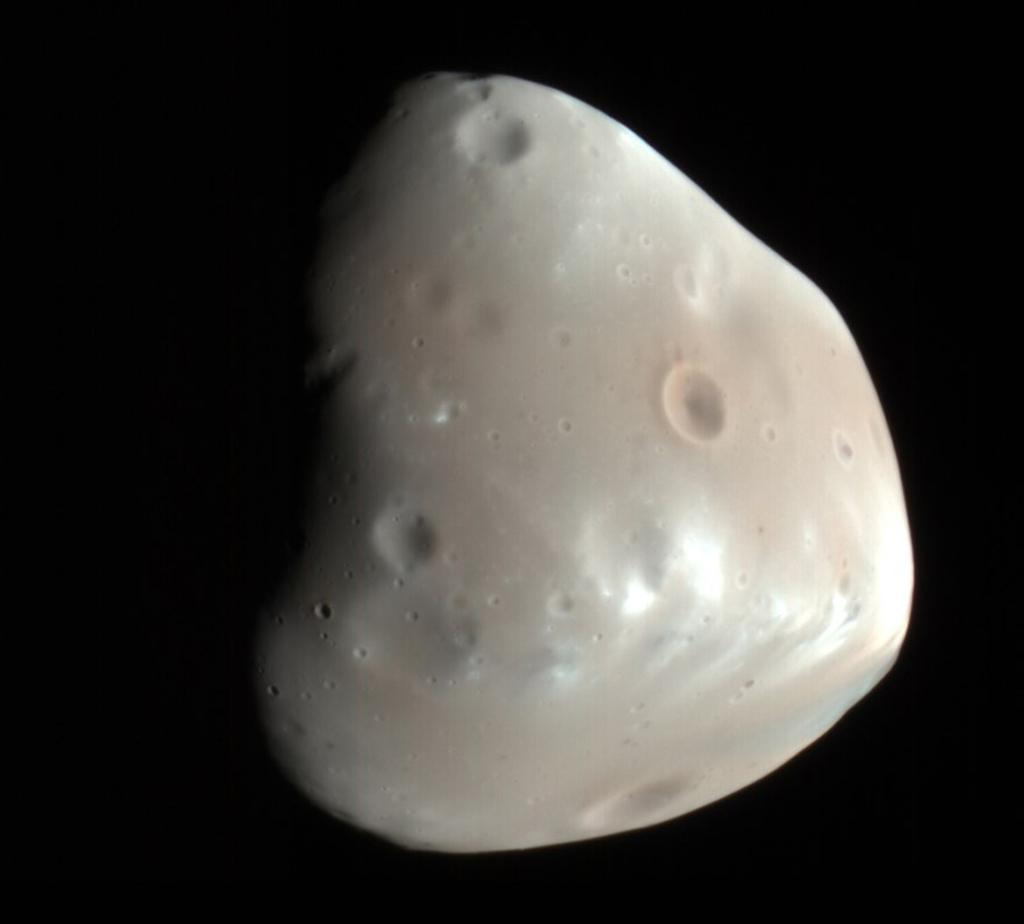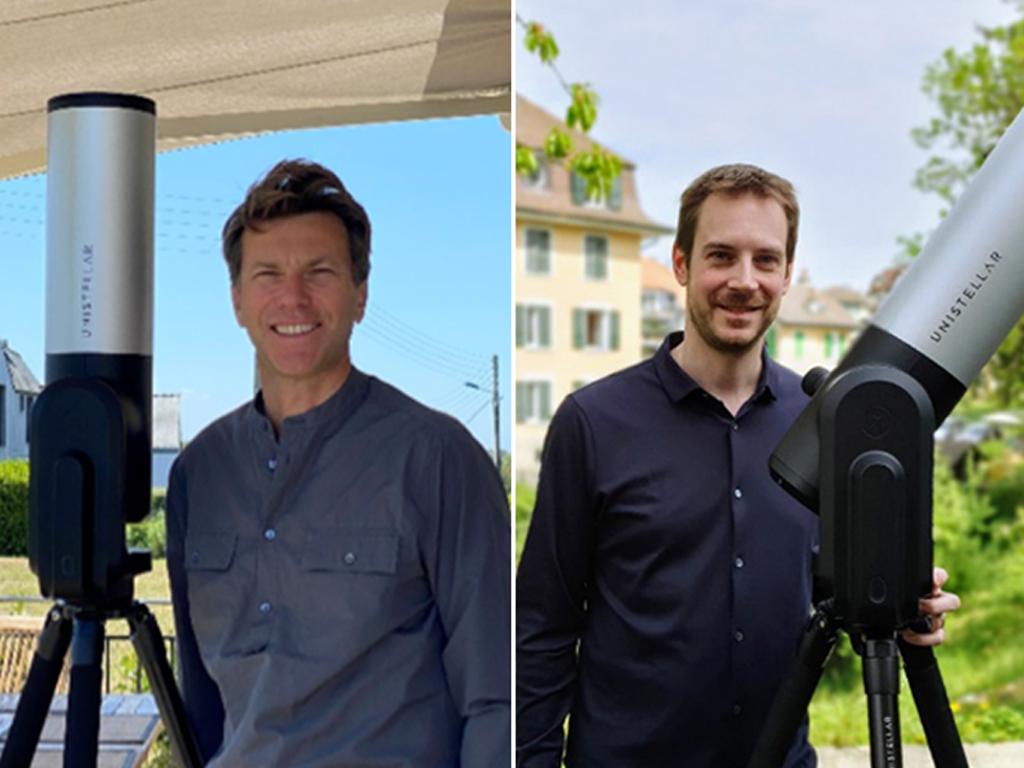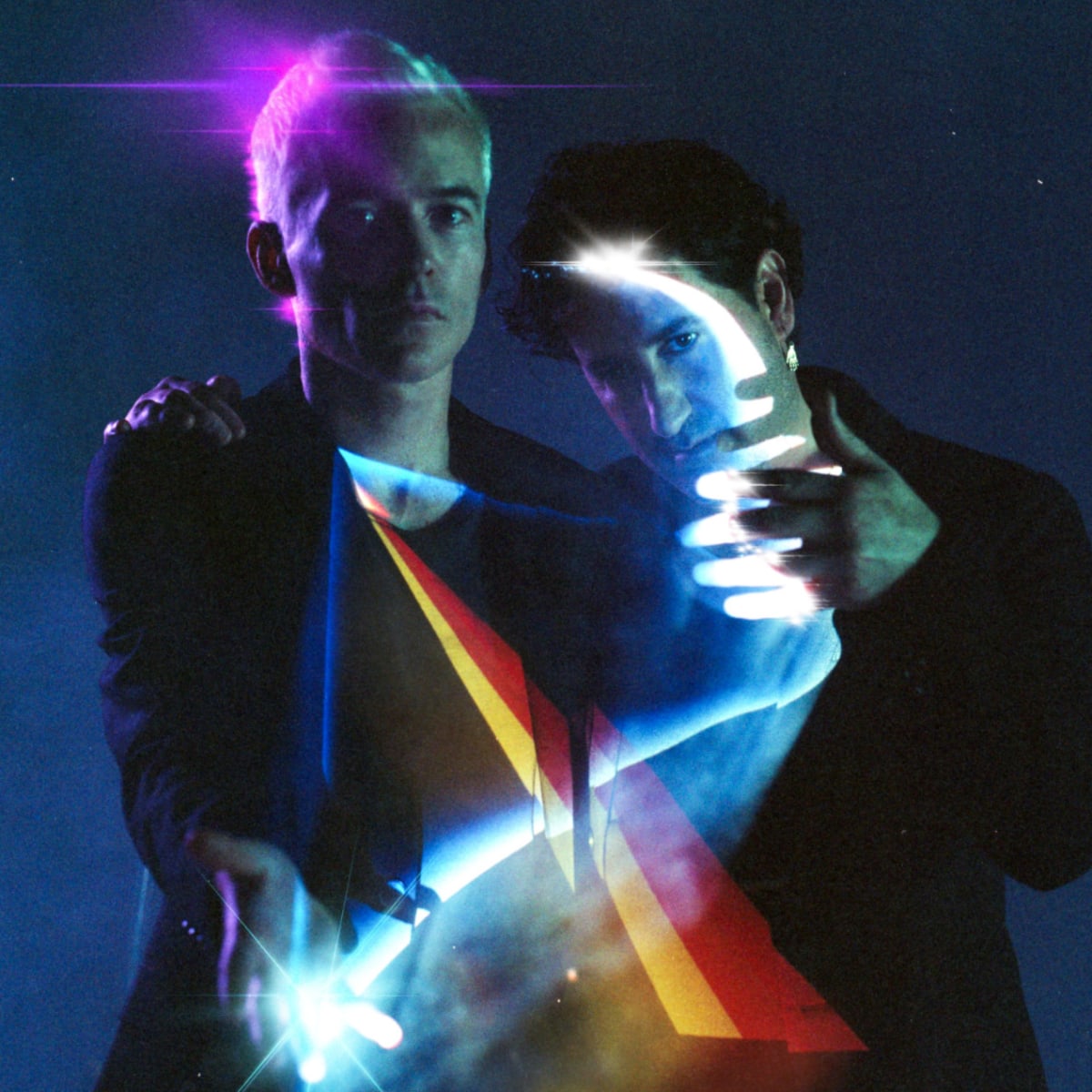
Scientists from the SETI Institute and Purdue University have found that the only way to produce Deimos’s unusually tilted orbit is for Mars to have had a ring billions of years ago. While some of the more massive planets in our solar system have giant rings and numerous big moons, Mars only has two small, misshapen moons, Phobos and Deimos. Although these moons are small, their peculiar orbits hide important secrets about their past.
- Shortpedia: How did the Red Planet lose several systems of rings over billion of years?
- Medium: Did Mars have Rings?
- Syfy Wire: Did Mars once have rings? Its mysterious moon Deimos might have the answer
- Parabolic Arc: Martian Moon’s Orbit Hints at an Ancient Ring of Mars
- Phys.org: Martian moon's orbit hints at an ancient ring of Mars
- EarthSky: Did ancient Mars have rings?
- News 18: Mars May Have Had a Massive Ring More Than a Billion Years Ago, Study Finds
- Popular Mechanics: Mars strange moons suggest the planet once had rings like Saturn
- Discover Magazine: Ancient Mars May Have Had Rings, Then Moons, Then Rings ...
- Inverse: Martian moon holds clues to an ancient ring around the planet
- New Scientist: Mar's moon Phobos may someday turn back into a ring around the planet
- SETI.org: Martian Moon’s Orbit Hints at an Ancient Ring of Mars
 Could Debris Discs Around Stars Provide Clues About How Planets Formed in Our Solar System?
Could Debris Discs Around Stars Provide Clues About How Planets Formed in Our Solar System?Researchers from the University of California Berkeley and other organizations, including the SETI Institute, released the most extensive collection of images showing debris discs around young stars, providing a glimpse of what our solar system might have looked like when its planets were forming. The images were part of data collected over four years by the Gemini Planet Imager (GPI), located on the Gemini South Telescope in Chile.
- Berkeley News: Rogue’s Gallery of Dusty Star Systems Reveals Exoplanet Nursuries
- Universe Today: Another Collection of Newly Forming Planetary Systems. This Time from the Gemini Planet Imager
- Newswise: Young Planets Bite the Dust, Astronomers unveil new collection of planet-forming dusty star systems
- SETI.org: Could Debris Discs Around Young Stars Provide Clues About How Planets Formed in Our Solar System?
- SETI.org: The Gemini Planet Imager Exoplanet Survey (GPIES)
- Astronomical Journal: Debris Disc Results from Gemini Planet Imager Exoplanet Survey’s Polarimetric Imaging Campaign
 Backyard Astronomy
Backyard AstronomyCitizen science pioneers recently made two contributions to a better knowledge of outer space. Backyard astronomers of the SETI Institute and Unistellar network conducted in April citizen science observations, and their discoveries will improve our understanding of asteroids and exoplanets. Thanks to their work, we know precisely the location of the main-belt asteroid 2000 UD52 and have confirmed an exoplanet transit of Qatar-1b.
- SpaceDaily: First Citizen Science Successes for Backyard Astronomy
- SETI.org: Detecting Exoplanets and Asteroids: First Citizen Science Successes for Backyard Astronomy
It’s anyone’s guess how many alien civilizations could be out in the cosmos. Experts recently weighed in with numbers ranging from 36 to a thousand.
According to a new analysis from scientists at the University of Nottingham, we don’t have a lot of alien company. On June 15, two researchers published a paper in the Astrophysical Journal arguing that the Milky Way – which sports about 250 billion stars – could host as few as 36 alien societies. That’s a small number, and rather less than the number of races that have appeared in Star Trek. The authors supplement their piddling tally with a second, more generous analysis in which they say that, OK, the count might be as many as a thousand. (Seth Shostak, SETI Institute Senior Astronomer)
- Universe Today: Calculate the Number of Alien Civilizations in the Milky Way for Yourself.
- Wired: The Trouble With Counting Aliens
- Fox News: Are there really 36 alien civilizations out there? Well, maybe
- SETI.org: How Many Alien Societies Are There?
 Frank Drake – Father of SETI
Frank Drake – Father of SETIFrank Drake, who recently turned 90, is a pioneer in the search for extraterrestrial life (SETI). 60 years ago, in 1960, he used an 85-foot radio telescope at the National Radio Astronomy Observatory (NRAO) in Green Bank, West Virginia, to make humanity’s first attempt to detect interstellar radio transmissions.
He was the first to probe the skies in an unprecedented way in an experiment he called Project Ozma. Drake was looking for signs of cosmic company: the presence of other intelligent beings on planets around other stars. (Seth Shostak)
- National Geographic: My dad launched the quest to find alien intelligence. It changed astronomy.
- SETI.org: The Father or SETI
 The Avalanches are Digitizing and Converting a 1974 Broadcast Signal Into Music
The Avalanches are Digitizing and Converting a 1974 Broadcast Signal Into MusicA historic piece of intergalactic communication will soon be ready for our listening pleasure.
A message that was first used in an attempt to contact intelligent life is now being turned into music. That's right, if you thought you'd seen it all when it comes to clever sampling and creative audio to MIDI conversions, Australian electronic duo, The Avalanches, are about to take things a step further.
It's unknown whether Frank Drake, creator of the 1974 Arecibo Message, envisioned his work being turned into a song several decades later, but that is exactly what's been teased in The Avalanches' latest post. (EDM.com)
 Weekly Space Hangout
Weekly Space HangoutCheck out Weekly Space Hangout with astrophysicist Dana Backman, who manages the NASA Airborne Astronomy Ambassadors (AAA) program for the SETI Institute.
- Universe Today: Weekly Space Hangout: June 17, 2020 — Dana Backman, Director of NASA Airborne Astronomy Ambassadors
 Scientists Discover Mysterious Radio Transmission From Space That Repeats 50-Minute Intervals Of Nonstop Classic Rock Blocks
Scientists Discover Mysterious Radio Transmission From Space That Repeats 50-Minute Intervals Of Nonstop Classic Rock BlocksRock from outer space is usually referring to a solid object, but not in this case. Researchers recently announced receiving radio transmissions from space in the form of classic rock music.
Expressing excitement over what could be a landmark discovery in the search for extraterrestrial life, scientists at the SETI Institute announced Tuesday they had received a mysterious radio transmission from space that repeats 50-minute intervals of nonstop classic rock blocks. “We detected a signal emanating from hundreds of thousands of lightyears away that, once deciphered, we realized was all the best hits from Zeppelin, Aerosmith, and the Doors in a back-to-back commercial-free format,” said SETI researcher Duane Hess, confirming that the transmission could potentially originate from an alien civilization of die-hard ’60s, ’70s, and ’80s rock fans. (The Onion, satirical news)
 How to Find Life on Mars
How to Find Life on MarsIn a recent Reddit Ask-Me-Anything (AMA), Pascal Lee of the SETI Institute and NASA’s Haughton-Mars Project at NASA Ames Research Center described genetic testing on samples from beneath the surface as the best way to find alien life on Mars.
“The only way to establish that life found on Mars is alien would be to do genetics on it and show that it does not belong to Earth's Tree of Life. In order to do genetics on it, we have to find it alive (or dead only very recently; not fossilized),” he explained.
“Until we explore the interiors of Mars' volcanoes (lava tubes) and/or drill deep into the Martian subsurface, we are unlikely to find any signature of life we can establish as alien, which is the main point of the search to begin with,” he stated. “No amount of fossil finding at the surface of Mars will tell you for sure that you've found alien life.”
- International Business Times: NASA Scientist Explains How To Find Alien Life On Mars
- Reddit: AskScience AMA Series: My name is Pascal Lee, and I am a planetary scientist at the SETI Institute and director of the NASA Haughton-Mars Project (HMP) at NASA Ames Research Center. AMA!
Laughing rats, sorrowful elephants, joyful chimpanzees. The more carefully we observe, and the more we learn about animals, the closer their emotional lives appear to resemble our own. Most would agree that we should minimize the physical suffering of animals, but should we give equal consideration to their emotional stress? Bioethicist Peter Singer weighs in. Meanwhile, captivity that may be ethical: How human-elephant teamwork in Asia may help protect an endangered species. Join guests Peter Singer, Frans de Waal, Jacob Shell and Kevin Schneider as we take a look at universal emotions in Animals Like Us.
Crowded subway driving you crazy? Sick of the marathon-length grocery store line? Wish you had a hovercraft to float over traffic? If you are itching to hightail it to an isolated cabin in the woods, remember, we evolved to be together. Humans are not only social, we’re driven to care for one another, even those outside our immediate family. Join guests Adam Rutherford, Patricia Churchland and Mark Moffett as we look at some of the reasons why this is so – from the increase in valuable communication within social groups to the power of the hormone oxytocin. Plus, how our willingness to tolerate anonymity, a condition which allows societies to grow, has a parallel in ant supercolonies in Let's Stick Together.
Sexist snow plowing? Data that guide everything from snow removal schedules to heart research often fail to consider gender. In these cases, “reference man” stands in for “average human.” Human bias also infects artificial intelligence, with speech recognition triggered only by male voices and facial recognition that can’t see black faces. Join guests Caroline Criado-Perez, Kade Crockford and Amy Webb as we question the assumptions baked into these numbers and algorithms in Skeptic Check: Data Bias.
While citizens take to the streets to protest racist violence, the pandemic has its own brutal inequities. Black, Latino, and Native American people are bearing the brunt of COVID illness and death. Join guests Marcella Nunez Smith, Utibe Essien, Nina Jablonski, Robert Sapolsky and Harold Frazier as we look at the multitude of factors that contribute to this disparity, most of which existed long before the pandemic. Also, how the Cheyenne River Sioux tribe maintained their coronavirus safeguards in defiance of the South Dakota governor. And, the biological reasons why we categorize one another by skin color in Race and COVID.
Some safeguards against COVID-19 don’t require a medical breakthrough. Join guests Cody Cassidy, Nina Jablonski and Eti Ben Simon as they discuss catching sufficient Z’s, sending viruses down the drain and how your first line of defense, your skin, is also neglected in Soap, Skin, Sleep.
Will Alexa laugh at your jokes or groan at your puns? In this episode, find out what’s involved in tickling A.I.’s funny bone with guest Julia Rayz, Steve Adler, Doug Vakoch and Richard Wrangham, as well as an interstellar communication challenge in Gained in Translation.
When can we expect a COVID vaccine? Guests Nigel Brown, Ian Haydon, Bonnie Maldonado and Paul Offit discuss timelines, how it would work, who’s involved and the role of human challenge trials in Vaccine, When?
Recent SETI Live episodes include:
- Animal Intelligence and the Search for Life Beyond Earth
- A Special SETI Live on Asteroid Day. Join us on June 30 2020 for a special #SETILive about Asteroids with American physicist and former NASA astronaut, Ed Lu. Ed is the co-founder of the B612 Foundation and its scientific program the Asteroid Institute, both dedicated to protecting the Earth from asteroid strikes. He will discuss with SETI Institute Senior Director of Education and STEM Programs, Simon Steel, on the role of the B612 Foundation in Planetary Defense at large, including protecting the planet but also informing and forwarding world-wide decision-making on this issue. Ed will share with us his first-hand experience, while using the Unistellar eVscope, a digital telescope developed in partnership with the SETI Institute which could have the potential to involve us in protecting our planet by bringing timely and accurate observations of potentially hazardous asteroids.
- SETI Live: Meet SETI Artists-in-Residence Director Bettina Forget and Advisor Dorka Keehn
- CHEOPS, CHaracterising ExOPlanet Satellite. Join us for a SETI Live with Laetitia Delrez (@LaetitiaDelrez) from the University of Liege and Kate Isaak, Project Scientist at ESA on CHEOPS.
- Citizen Science Discoveries: Exoplanets and Asteroids
- Martian Moon's Orbit Hints at Ancient Rings of Mars
- Imaging the Birth of a Planet - In discussion with Astronomer Anthony Boccaletti from the Observatoire de Paris who will tell us about the incredible of the young star AB Aurigae revealed by the European Southern Observatory last week. These new observations collected with a cutting-edge adaptive optics system reveal complex features around the young star including a twist that marks the site where a planet may be forming. Together with SETI Institute senior astronomer Franck Marchis, Boccaletti will explain how astronomers get crucial clues on the formation of exoplanets from this kind of image.
- Astronomers Capture Images of Infant Planets, a conversation with Jason Wang and Franck Marchis
- SETI Talks: Finding Life on Europa: Do we have the chemistry? NASA, together with other space agencies, is looking for a way to explore Europa and hopefully identify the presence of life after solving technological challenges like landing on a chaotic and cryogenic surface, drilling into its crust and analyzing samples directly. If there is an ocean of liquid water beneath the relatively thin ice shell of Europa, is life there as well?
As always, videos of all past Facebook Live events can be found on our Facebook page: https://www.facebook.com/SETIInstitute/
Or on our YouTube channel: https://www.youtube.com/SETIInstitute





